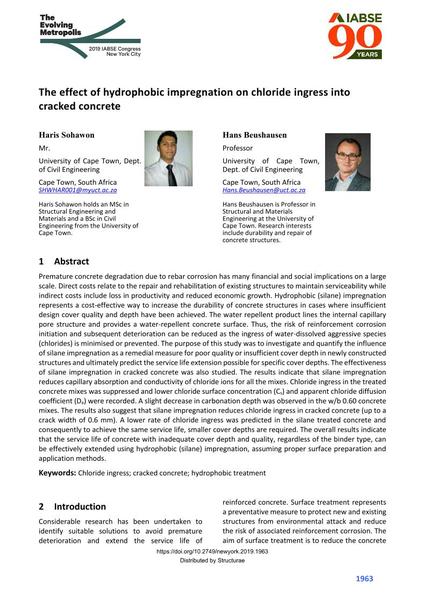The effect of hydrophobic impregnation on chloride ingress into cracked concrete

|
|
|||||||||||
Bibliografische Angaben
| Autor(en): |
Haris Sohawon
(University of Cape Town, Dept. Of Civil Engineering)
Hans Beushausen (University of Cape Town, Dept. of Civil Engineering) |
||||
|---|---|---|---|---|---|
| Medium: | Tagungsbeitrag | ||||
| Sprache(n): | Englisch | ||||
| Tagung: | IABSE Congress: The Evolving Metropolis, New York, NY, USA, 4-6 September 2019 | ||||
| Veröffentlicht in: | The Evolving Metropolis | ||||
|
|||||
| Seite(n): | 1963-1970 | ||||
| Anzahl der Seiten (im PDF): | 8 | ||||
| DOI: | 10.2749/newyork.2019.1963 | ||||
| Abstrakt: |
Premature concrete degradation due to rebar corrosion has many financial and social implications on a large scale. Direct costs relate to the repair and rehabilitation of existing structures to maintain serviceability while indirect costs include loss in productivity and reduced economic growth. Hydrophobic (silane) impregnation represents a cost-effective way to increase the durability of concrete structures in cases where insufficient design cover quality and depth have been achieved. The water repellent product lines the internal capillary pore structure and provides a water-repellent concrete surface. Thus, the risk of reinforcement corrosion initiation and subsequent deterioration can be reduced as the ingress of water-dissolved aggressive species (chlorides) is minimised or prevented. The purpose of this study was to investigate and quantify the influence of silane impregnation as a remedial measure for poor quality or insufficient cover depth in newly constructed structures and ultimately predict the service life extension possible for specific cover depths. The effectiveness of silane impregnation in cracked concrete was also studied. The results indicate that silane impregnation reduces capillary absorption and conductivity of chloride ions for all the mixes. Chloride ingress in the treated concrete mixes was suppressed and lower chloride surface concentration (Csand apparent chloride diffusion coefficient (Da) were recorded. A slight decrease in carbonation depth was observed in the w/b 0.60 concrete mixes. The results also suggest that silane impregnation reduces chloride ingress in cracked concrete (up to a crack width of 0.6 mm). A lower rate of chloride ingress was predicted in the silane treated concrete and consequently to achieve the same service life, smaller cover depths are required. The overall results indicate that the service life of concrete with inadequate cover depth and quality, regardless of the binder type, can be effectively extended using hydrophobic (silane) impregnation, assuming proper surface preparation and application methods. |
||||
| Stichwörter: |
gerissener Beton
|
||||
